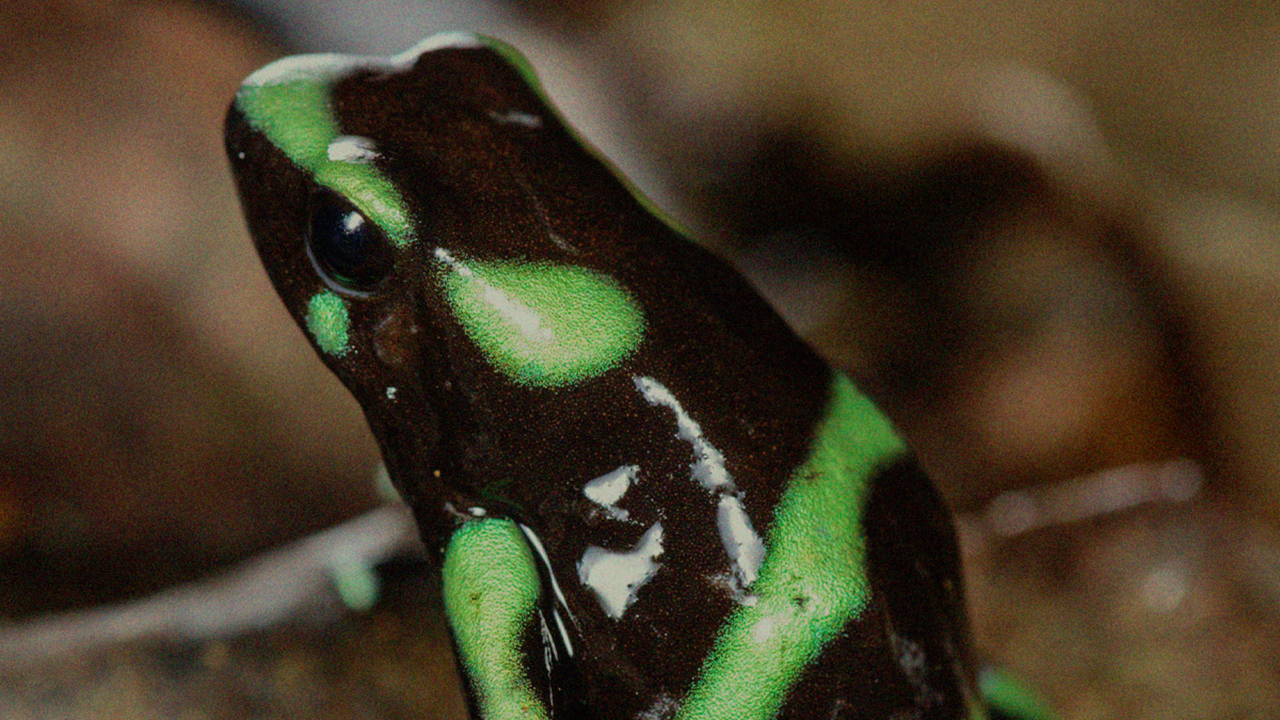

Photograph by Nick Garbutt / NaturePL
words by willow defebaugh
“To pay attention, this is our endless and proper work.” —Mary Oliver
The cathedral towered over the riverbank—built not of ashy stone, but of vernal vines, so many that it was impossible to disentangle where one ended and the next began. Sprouting along their lengths were purple-pink flowers that seemed to cast an enchanting glow against the dark green backdrop. As we floated past on the Rio San Carlos in Costa Rica, our guide explained that the vines were parasites. They cover the tree canopy to be closer to the sunlight, while the tree below slowly withers in their shade. “There is a dark side to beauty,” Luis said.
It wasn’t the last time this theme would emerge on this trip. The next day, my Atmos colleagues and I found ourselves in the thick of the jungle, moisture hanging heavy in the air as we stared intently at a bright red dart frog the size of a fingernail. Its arresting color was adapted to do exactly that: Halt predators in their tracks by communicating that it’s toxic. When animals use distinct warning signs—like vivid color—to ward off would-be attackers, it’s known as aposematism. What we see as beautiful, other animals might see as dangerous.
Poison frogs are a commonly used example of aposematism. Their electric blue, engine red, and bold orange hues communicate to the rest of the rainforest that their beauty is toxic. One golden dart frog contains enough poison to kill 20,000 mice. They are so toxic that just one brush of a dart tip across their back can take down a monkey. For these tiny amphibians, the poison they secrete through their skin is not one borne of willful malevolence or even an adaptation to help them catch prey, but most likely a consequence of their diet.
While observing this tiny drop of deadly crimson, Luis once again referenced the dark side of beauty. But as I reflected on its psychedelic colors continuing through the jungle, I wondered if that was really a fair assessment. After all, the frog’s coloration could also be seen as a vibrant display of authenticity. You could argue that it’s out of self-preservation, but aren’t they also protecting their predators? This pushes other animals in their ecosystem to be smarter, as well, passing along the knowledge of what to eat and what to avoid within their species, too.
Beauty can be an act of ecological integrity. Plenty of plants and animals evolved to be beautiful to attract attention. Flowers are the sexual organs of plants, and have bloomed in endless shapes, shades, and displays of inflorescence to draw in pollinators—who are fed not only by their beauty, but their pollen. What we see as soft petals of pastels are actually ultraviolet beacons in the eyes of bees. Many pollinators and plants have coevolved, adapting in response to one another: a sacred dance of beauty from which the entire ecosystem benefits.
As we continued our trek, our guide pointed out fresh leaves unfurling in strokes of red before turning green. These species, he told us, have learned to mimic the aposematism of other beings: By starting out red, they signal danger and protect their leaves when they are at their most vulnerable, despite not actually being toxic. Other animals have adapted this way, too: harmless scarlet kingsnakes that mimic the red, black, and yellow coloration of deadly coral snakes, for example. Sometimes, beauty can be a shield—and an act of survival.
Maybe beauty is too unruly to be boxed into human notions of solely good or bad. It can shield and sustain as easily as it can strangle and seduce. In the wild world, every hue has a purpose. Every shade is a story told between prey and predator, plant and pollinator, self and other. What if the true function of beauty is to wake us up? To invite us into a deeper awareness and level of ecological integrity? To help us tell the difference between danger and desire, what poisons and feeds us? Perhaps beauty is a sacred instruction from life itself: Pay attention.
Aposematism and The Beauty of Awareness